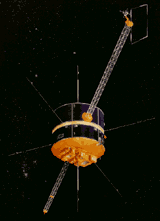Polar
 Polar, and its sister spacecraft Wind, are NASA's contribution to the International Solar Terrestrial Program (ISTP), an international effort to quantify the effects of solar energy on the Earth's magnetic field. Polar is designed to measure the entry, energization, and transport of plasma into the magnetosphere. The mission's specific objectives are to (1) investigate energy input to the ionospheric region through the dayside cusp; (2) determine the mechanisms of ionospheric plasma outflow; (3) study the characteristics of the auroral plasma acceleration regions; (4) provide global, multispectral auroral images of the footprint of magnetospheric energy
disposition into the ionosphere and upper atmosphere; (5) help determine the role of
the ionosphere in substorm phenomena and the overall magnetospheric energy balance; and (6) document ions leaving the atmosphere and subsequently appearing in
the solar wind, or electrons of solar wind origin precipitating to auroral altitudes. Data
from Polar will be correlated with data from ground-based scientific observatories and
the other spacecraft in the ISTP program (Wind, Geotail and SOHO (the Cluster
spacecraft would also have participated, but were destroyed during launch)) to better
understand the physical effects of solar activity on interplanetary space and the Earth's space environment.
Polar, and its sister spacecraft Wind, are NASA's contribution to the International Solar Terrestrial Program (ISTP), an international effort to quantify the effects of solar energy on the Earth's magnetic field. Polar is designed to measure the entry, energization, and transport of plasma into the magnetosphere. The mission's specific objectives are to (1) investigate energy input to the ionospheric region through the dayside cusp; (2) determine the mechanisms of ionospheric plasma outflow; (3) study the characteristics of the auroral plasma acceleration regions; (4) provide global, multispectral auroral images of the footprint of magnetospheric energy
disposition into the ionosphere and upper atmosphere; (5) help determine the role of
the ionosphere in substorm phenomena and the overall magnetospheric energy balance; and (6) document ions leaving the atmosphere and subsequently appearing in
the solar wind, or electrons of solar wind origin precipitating to auroral altitudes. Data
from Polar will be correlated with data from ground-based scientific observatories and
the other spacecraft in the ISTP program (Wind, Geotail and SOHO (the Cluster
spacecraft would also have participated, but were destroyed during launch)) to better
understand the physical effects of solar activity on interplanetary space and the Earth's space environment.
Spacecraft
Cylindrical with body mounted solar arrays. Spin stabilized at 10 rpm. 2 pairs of wire
booms for the Plasma Wave Instrument (PWI) experiment. One belt antenna and 4
low-gain antennas.
Payload
Plasma Wave Investigation (PWI) - designed to provide comprehensive measurements of plasma wave phenomena in the high latitude auroral zones, dayside magnetic cusp regions, plasmasphere and plasmasheet.
Fast Plasma Analyzer (HYDRA) - will measure the rapid very low energy of the 3-dimensional ion and electron distribution function.
Magnetic Fields Experiment - a magnetometer designed to measure the magnetic fields in the high and low altitude polar magnetosphere. This experiment will
investigate the behavior of field-aligned current systems and the role they play in the
acceleration of particles and the dynamics of the fields in the polar cusp, magnetosphere, and magnetosheath.
Toroidal Imaging Mass-Angle Spectrograph (TIMAS) - measures the 3-dimensional velocity distribution functions of all major magnetospheric ion species.
Electric Field Instrument (EFI) - measures the three components of the ambient vector electric field and the thermal electron density.
Thermal Ion Dynamics Experiment (TIDE) and Plasma Source Instrument (PSI) - will track the outflow of ionospheric plasma throughout the magnetosphere.
Ultraviolet Imager (UVI) - a two dimensional imager sensitive to far ultraviolet wavelengths with an 8 deg. circular FOV. The instrument will conduct observations of both the sunlit and nightside polar regions in the far ultraviolet wavelengths to help quantify the overall effects of solar energy input to the earth's polar regions.
Visible Imaging System (VIS) - a set of three low-light-level cameras designed to provide images of the aurora.
Polar Ionospheric X-ray Imaging Experiment (PIXIE) - will measure the spatial distribution and temporal variation of x-ray emissions in the energy range 3 to 60 keV from the earth's atmosphere.
Charge and Mass Magnetospheric Ion Composition Experiment (CAMMICE) - will determine the composition of the energetic particle populations of the Earth's magnetosphere to identify how these charged particles are energized and transported from their source to the magnetosphere.
Comprehensive Energetic Particle Pitch Angle Distribution -
| Country of Origin | United States |
| Customer/User | NASA, GSFC |
| Manufacturer(s) | Lockheed-Martin |
| Size | 2.44m diameter x 1.85 m tall |
| Orbit | 11500 x 56500 km, incl. = 90 deg. |
| Design Life | 3 years |
| Related Sites | Polar Description at GSFC |
Launch Facts
| Name | Int'l Desig. | Date | Site | Vehicle | Orbit | Mass(kg) |
| Notes | ||||||
| Polar | 1996-013A | 2/24/96 | WSMC | Delta 2 | HEO | 1300 |
| Fields and particles, auroral studies; part of International Solar Terrestrial Physics program | ||||||
Information in The Mission and Spacecraft Library is provided without warranty or guarantee. USE AT YOUR OWN RISK.